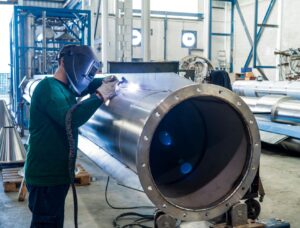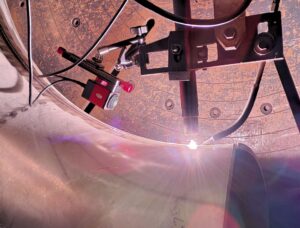Welding plays a critical role in the oil and gas industry, ensuring the strength, durability, and safety of pipelines, offshore platforms, refineries, and storage tanks. Given the high-pressure environments and harsh operating conditions, precision welding is essential to prevent leaks, structural failures, and costly downtime. Discover how welding supports critical oil and gas infrastructure, from pipelines to offshore platforms and refineries. With advancements in welding technology, tools like Mecaweld’s welding cameras help improve quality control by providing real-time monitoring and defect detection, ensuring weld integrity in critical applications.
Key Applications of Welding in the Oil and Gas Industry
Pipeline Welding: Ensuring Leak-Proof Transport
Oil and gas pipelines transport crude oil, natural gas, and refined products across vast distances. These pipelines must withstand high pressure, temperature fluctuations, and corrosion.
Common Welding Techniques for Pipelines:
- Gas Metal Arc Welding (GMAW): Ideal for automated pipeline welding due to its high efficiency.
- Shielded Metal Arc Welding (SMAW): Commonly used for field repairs and remote pipeline installations.
- Orbital Welding: Ensures precision and consistency in pipeline joints.
How Mecaweld Helps:
- Welding cameras provide real-time monitoring of pipeline welds, detecting welding defects like porosity and incomplete fusion before they lead to failures.
Offshore Platforms: Welding in Extreme Conditions
Offshore oil rigs and platforms operate in harsh marine environments with exposure to saltwater, strong winds, and high-pressure conditions. Welded joints must be resistant to corrosion, fatigue, and extreme weather.
Common Welding Methods for Offshore Structures:
- Submerged Arc Welding (SAW): Used for fabricating large structural components.
- Flux-Cored Arc Welding (FCAW): Ideal for outdoor and high-wind conditions.
- Gas Tungsten Arc Welding (GTAW/TIG): Provides precision in critical joints.
How Mecaweld Helps:
- Real-time weld monitoring ensures strong, corrosion-resistant welds for offshore structures.
Refinery and Petrochemical Plant Welding
Refineries process crude oil into various fuels and chemicals, requiring high-temperature-resistant welded joints for safety.
Key Welding Applications in Refineries:
- Welding pressure vessels and boilers to withstand extreme heat and pressure.
- Joining storage tanks and pipelines to prevent hazardous leaks.
- Fabricating structural components for refinery frameworks.
How Mecaweld Helps:
- Welding cameras detect potential cracks, inclusions, or weak spots in high-temperature environments.
Oil and Gas Pipelines: Transporting Energy Across Borders
Oil and gas pipelines require high-quality welds to prevent leaks, corrosion, and structural failures. Pipeline welding demands precision due to high-pressure operations and environmental exposure.
- Automated orbital welding and Gas Metal Arc Welding (GMAW) are commonly used for pipeline construction.
- Weld quality is crucial in preventing environmental disasters and ensuring efficient transportation of resources.
How Mecaweld Helps:
- Real-time weld monitoring ensures pipelines meet industry safety and quality standards, reducing failure risks.
Storage Tank Welding: Preventing Failures
Oil storage tanks must be leak-proof and resistant to corrosion. Poor weld quality can lead to catastrophic spills, environmental damage, and financial losses.
Common Welding Techniques:
- Vertical Seam Welding: Used for large storage tank construction.
- Automatic Girth Welding: Ensures precise, consistent welds on tank walls.
How Mecaweld Helps:
- Welding cameras improve quality assurance, preventing leaks and ensuring compliance with industry standards.
Challenges in Oil and Gas Welding
High-Pressure and High-Temperature Environments
Pipelines and refinery components must withstand extreme pressures and temperatures without weld failures.
Solution: Use high-strength alloys and real-time weld monitoring to ensure defect-free welding.
Corrosion and Environmental Damage
Offshore platforms and pipelines are highly susceptible to corrosion from saltwater and chemicals.
Solution: Use corrosion-resistant materials, advanced welding techniques, and monitor weld quality with high-resolution cameras.
Safety Risks and Compliance Regulations
The oil and gas industry must comply with strict safety regulations, such as API (American Petroleum Institute) and ASME (American Society of Mechanical Engineers) standards.
Solution: Implement real-time weld inspection, non-destructive testing (NDT), and advanced welding cameras for enhanced safety compliance.
Advancements in Welding Technology for Oil & Gas
Automated and Robotic Welding
Automation improves efficiency, accuracy, and safety in oil and gas welding.
How Mecaweld Helps:Welding cameras integrate with robotic systems for real-time defect detection in automated pipeline welding.
Non-Destructive Testing (NDT) and Weld Monitoring
NDT methods like radiographic and ultrasonic testing help identify hidden defects in welds.
How Mecaweld Helps:Advanced welding cameras enhance visual inspections and reduce the risk of weld failures.
Safety Measures in Oil and Gas Welding
Preventing Weld Failures
- Use high-quality filler materials to enhance weld durability.
- Ensure proper preheating and post-weld heat treatment to prevent cracking.
- Monitor the weld pool using Mecaweld’s high-precision welding cameras.
Protecting Workers from Hazards
- Wear PPE (Personal Protective Equipment) such as welding helmets, fire-resistant clothing, and respirators.
- Use proper ventilation in confined spaces to avoid exposure to harmful welding fumes.
- Implement automated monitoring to minimize direct worker exposure to hazardous environments.
Conclusion:
Welding is a critical component in the oil and gas industry, ensuring the strength, safety, and efficiency of pipelines, offshore platforms, refineries, and storage tanks. By utilizing advanced welding techniques and real-time monitoring solutions like Mecaweld’s welding cameras, companies can improve weld quality, enhance safety, and comply with industry regulations.
Enhance your welding process with cutting-edge monitoring technology. Contact Mecaweld today for high-precision welding solutions!



